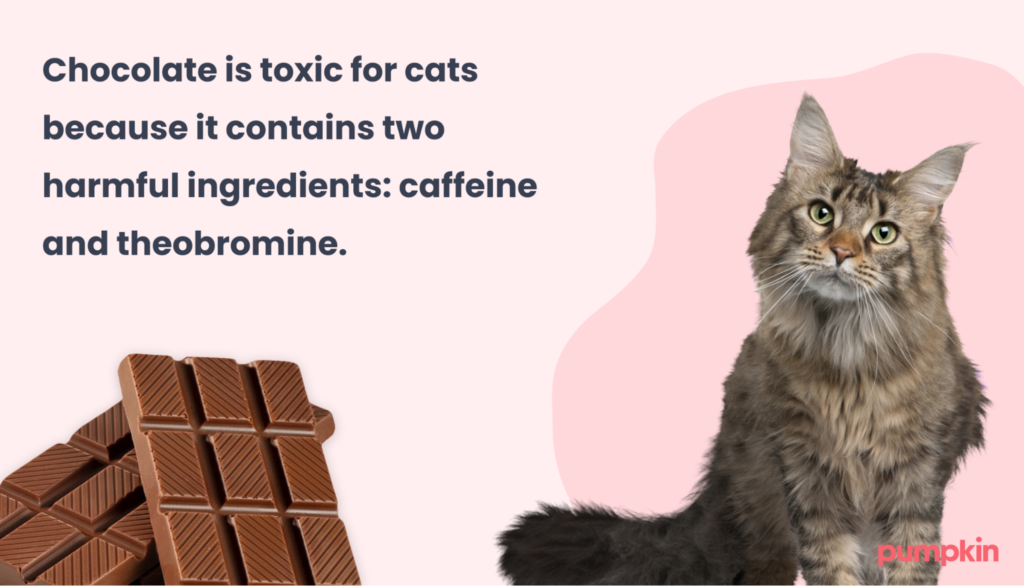- Emma Radmilovic
- Sep 30, 2021
- 6 min read
Updated: Jun 26
Key Points
Chocolate is not safe for cats to consume, so be cautious if your cat has a sweet tooth (which is pretty unlikely).
Chocolate contains two ingredients that are harmful for cats: caffeine and theobromine.
Even a small amount of chocolate can cause serious health issues, and some effects could put a cat's life at risk.
You may be a chocolate fiend, but hopefully, your feline friend isn’t. Most pet owners know to keep this human treat away from dogs, but fewer may be aware that chocolate is toxic for cats, too.
If your cat eats chocolate, they can suffer life-threatening health problems. The larger the amount of chocolate consumed (and the smaller the cat), the more dangerous the effects can be. Luckily, cats aren't programmed to like sweets. In fact, they lack the taste buds for sweet flavors — so if your cat is vying for a bite of your ice cream sundae, they may be interested in the fat content or creamy texture.
Here’s why you should keep chocolate away from your cat, and what to do if they consume chocolate without your permission (as if that would ever stop any self-respecting cat).
Why can’t cats eat chocolate like humans can?
Chocolate is toxic for cats because it contains two harmful ingredients: caffeine and theobromine. A cat’s small body can’t absorb and process these chemicals in the same way that human bodies can. These are the same ingredients that make chocolate toxic for dogs, too.
Caffeine
Caffeine is a stimulant commonly found in coffee and energy drinks. However, many people don’t realize that caffeine is also present in chocolate, albeit in smaller amounts. This delicious food is made from cacao beans, which contain natural caffeine.
Caffeine stimulates brain activity and our central nervous system. While humans can typically tolerate a caffeine boost, cats are far more sensitive and struggle with even small amounts. Caffeine can negatively impact your cat’s nervous system and their heart rate. It can also lead to liver failure and damage major organs like kidneys.
Theobromine
Theobromine is an alkaloid found in cacao beans that is potentially lethal for cats. Cats can’t absorb theobromine and won't pass it through their system as quickly as humans do. Left circulating in a cat's body, theobromine can negatively affect the nervous, cardiovascular, and respiratory systems.
It also has a diuretic effect, causing increased loss of water and salt from the body. This can quickly lead to theobromine poisoning, which is characterized by symptoms like vomiting, restlessness, and diarrhea.

Are all types of chocolate toxic for cats?
Yes, every type of chocolate is dangerous for your cat, but to varying degrees:
Dark chocolate has the highest levels of theobromine, making it the most dangerous for cats.
Milk chocolate is less concentrated than dark chocolate, but can still lead to poisoning.
White chocolate is the least toxic type of chocolate since it contains no caffeine and virtually no theobromine. However, white chocolate still poses a health risk because of its high sugar and butter content.
Remember: Even tiny amounts of any kind of chocolate can be bad for your cat. Resist the urge to give your cat a taste of any desserts or baked goods containing baking chocolate, chocolate powder, or chocolate syrup.
Is there any amount of chocolate that’s safe for cats?
Not really. The seriousness of chocolate poisoning in cats depends on the amount consumed relative to your cat’s body weight. The smaller your cat, the smaller the amount of chocolate it takes to bring on negative health effects.
If your cat happens to lick some chocolate ice cream or nibble on a small piece of chocolate, it likely won’t be life-threatening, but it can still be harmful.
Chocolate poisoning in cats is less common than chocolate poisoning in dogs because cats likely won’t seek out chocolate to eat. They’re a little more discerning about what they consume — and we say this with all due respect to our favorite dogs. But there’s still a chance cats can mistakenly be given chocolate as a treat, or eat it accidentally if human food is left out (so be sure to refill the cat food).
It’s always better to be careful, as what might not bother one cat could cause health issues for another. Since you can’t know for sure how they’ll react, keep all chocolate and chocolate-y desserts out of your cat's reach.
Chocolate poisoning in cats: symptoms
If your cat starts to show chocolate poisoning symptoms, you need to act quickly. The symptoms will depend on the amount and type of chocolate consumed. Your cat absorbs theobromine slowly, so symptoms may not show up right away, appearing anywhere between 2 and 24 hours after ingestion.
Here’s how to tell if your cat is sick because of chocolate poisoning:
Dehydration (excessive thirst)
Frequent urination
Loss of appetite
Restlessness or hyperactivity
Panting
Higher than usual heart rate
Muscle tremors
Choking (if chocolate contains other ingredients like nuts or raisins)
Potential long-term health risks of chocolate for cats
The short-term symptoms aren’t the only things to worry about when a cat eats chocolate. It can also cause long-term damage to their health. Here are some of the serious risks:
Cardiac arrest
Even small amounts of theobromine and caffeine in chocolate can overstimulate your cat’s heart, leading to a rapid or irregular heartbeat. Over time, repeated exposure or high amounts can lead to heart failure or even cardiac arrest.
Kidney failure
Theobromine and caffeine in chocolate can damage a cat's kidneys by causing dehydration and electrolyte imbalances. Over time, this stress on the kidneys can lead to kidney failure, especially in cats with existing kidney issues.
Neurological damage
Chocolate toxicity can affect a cat’s nervous system, causing tremors, seizures, and other symptoms. If a cat eats chocolate regularly, it can cause lasting damage to their motor skills, coordination, and brain function.
What should I do if my cat eats chocolate?
Take your cat to the nearest veterinary clinic or call ASPCA Animal Poison Control (open 24/7). They can guide you through the next steps. If your cat has ingested a toxic amount of chocolate, they’ll need treatment as soon as possible.
The faster you act, the better the chances of a positive health outcome for your cat.
How is chocolate poisoning treated?
Treatment will depend on the amount of chocolate your cat has ingested and how much time has passed since ingestion. At the vet, your cat will be assessed and may undergo the following treatments:
Induce vomiting: A veterinarian may try to help by inducing vomiting, which is very difficult for cats. (Do not try to do this yourself.)
Activated charcoal: Your vet may give your cat activated charcoal to absorb the toxins from the chocolate and prevent these toxins from being absorbed into the bloodstream.
Fluid therapy: In serious cases, a veterinarian may administer intravenous fluid (IV) therapy to deliver medication directly into your cat’s bloodstream to keep them hydrated and dilute toxins.
Your cat will need to be kept on a bland, plain diet after chocolate poisoning treatment and watched closely for several days.
Having pet insurance comes in handy if your cat gets hurt or sick unexpectedly, so don't wait. Consider Pumpkin’s cat insurance plans to help cover the costs of eligible vet bills, so you can get your cat the best possible care when they need it.
What kind of treats can I give my cat safely?

Pet stores sell a variety of cat treats that are great options for satisfying your cat safely. No matter where you get them, it’s always best to check the ingredients list on any treat and ask your veterinarian for advice if you’re unsure.
Here are some of our favorite safe cat snacks and treats:
Cooked chicken and beef
Cheese (in moderation)
Melon
Cooked fish
Pureed pumpkin
Cantaloupe
Skinless apples
Paws off the chocolate
For your cat’s sake, keep them away from chocolate — preventing an accident is better than having to treat it. Any amount could be dangerous or potentially life-threatening. Be vigilant when chocolate is around, and be prepared to act quickly if you notice something’s not right with your cat.

